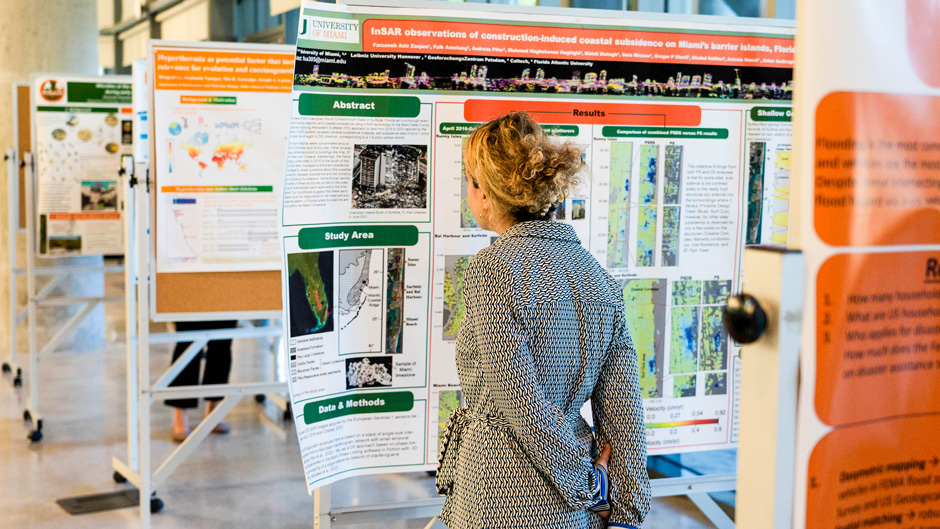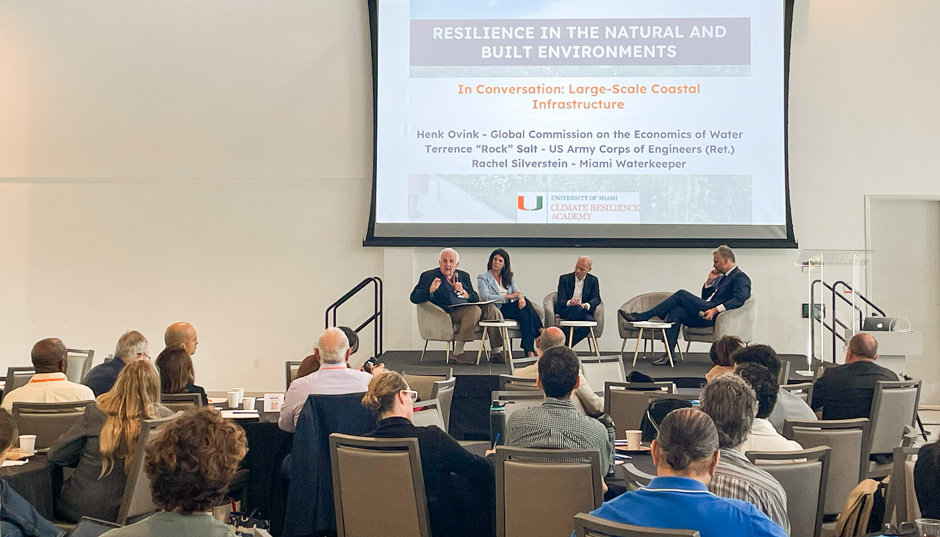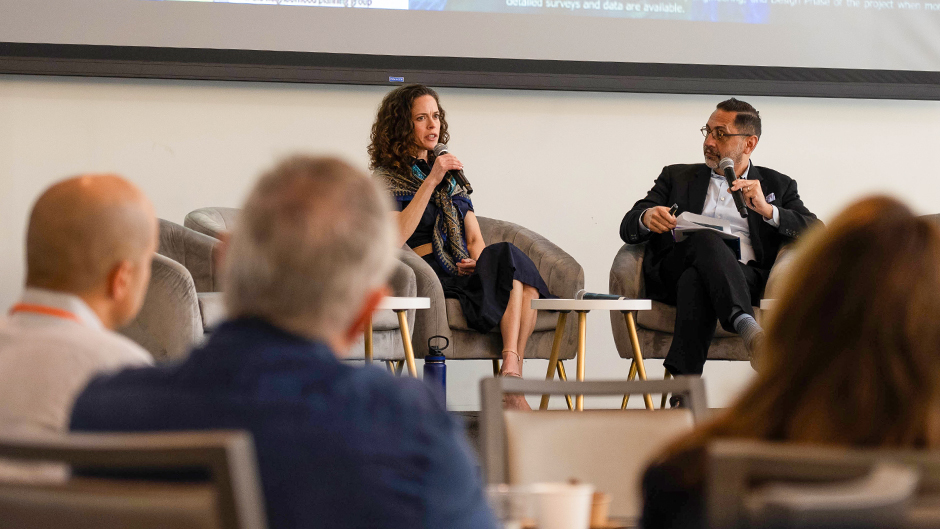Resilience leaders from academic institutions, nonprofits, business, and government came together to learn about the adaptations happening in urban areas across the world Wednesday at the third Climate Resilience Symposium, hosted at the University of Miami.
Organized by the Climate Resilience Academy, the one-day conference titled “Resilience in the Built and Natural Environments,” aimed to help students and policymakers build an “ecosystem of expertise,” so that sustainable solutions could be created, discussed, and replicated as the world continues to grapple with a warming climate, said Michael Berkowitz, its executive director. He also stressed the importance of including students in the conversation.
“The issues we are talking about are multigenerational, and without students, this isn’t going to work,” said Berkowitz, the Eric T. Levin Endowed Chair in Climate Resilience, who came to the University after creating the 100 Resilient Cities network at The Rockefeller Foundation. The academy offers an interdisciplinary undergraduate course taught by 12 instructors from across the University.
It will take a collective effort, with science playing a key role, to address those challenges, Miami-Dade County’s chief resiliency officer, James Murley, told the audience.
“We always have to recognize that we’re building on science—the science that we get from our universities and from our wonderful federal and state institutions that work on this,” said Murley, calling for greater public scrutiny of that science. “We have to be transparent to the community that we’re not making this stuff up about sea level rise. It’s based on science, it’s based on experience, on empirical data.”

From The Underline—which is transforming the land below Miami’s Metrorail into a 10-mile linear park, urban trail, and public art destination—to collecting seaweed from the shores of local beaches and converting it to compost, Miami-Dade County Mayor Daniella Levine Cava detailed some of the sustainable initiatives implemented locally in the past few years. She also applauded the University for its deployment of hybrid reefs in the waters off North Beach Oceanside Park to help protect coastal environments and help attract marine life.
Carlos Martín, director of the Remodeling Futures Program in the Joint Center for Housing Studies at Harvard University, and Annie Lord, executive director of Miami Homes for All, discussed “Housing that Builds Resilience” during the symposium’s opening keynote panel.
Both noted that for cities like Miami to thrive, they need to include housing in resilience planning. Martín called attention to the advancing age of the nation’s housing stock, noting that the median age of a home in the U.S. is now 41 years. He also mentioned that living in a place like South Florida is becoming unaffordable, noting that Miami-Dade County has the highest percentage of residents in the nation spending more than 50 percent of their income on housing costs.
“Our housing is entering middle age,” he said. “That means there’s a lot of fixing that needs to occur. But we don’t repair our homes, we don’t have the resources to repair our homes. That’s particularly concerning for people with low incomes and who live in vulnerable communities.”
Lord lamented that development and large-scale infrastructure projects are displacing lower-income residents, some of whom live in neighborhoods located at higher elevations, making them less vulnerable to flooding and the effects of sea level rise.
“There’s a very strong awareness among lower-income communities of color in Miami-Dade that they’ve got a target on their backs, that their neighborhoods are under threat, and that they could be forced to hand their communities over,” she said.
Other speakers delved into strategies that have helped urban areas adapt to climate change at the community level. Marta Viciedo, Miami program director for the John S. and James L. Knight Foundation and Maria Nardi, Miami-Dade County director of Parks, Recreation and Open Spaces, talked about an effort with the City of North Miami to purchase a residential lot that was predisposed to heavy flooding. With the neighborhood’s input, it was turned into Good Neighbor Stormwater Park, complete with a retention pond to collect the floodwater. Today it is a place that residents enjoy using as a recreational trail and may serve as the prototype for a chain of similar parks.
“This shows what happens when you think about a place and the people who live there and get their input, and hear what they need,” Viciedo said. “This was a culturally sensitive project to build the beginning of a solution, and that’s part of what’s possible.”
A concern for how climate change is inequitably impacting underserved communities was mentioned by many speakers, including Benita Hussain, chief program officer of tree equity for American Forests. Hussain talked about using trees as a way for cities to counteract extreme heat and to improve the health of residents. Yet, she noted that low-income communities have 26 percent less tree cover and are 7 degrees hotter on average. In communities of color, the statistics were even more stark. Meanwhile, a European study showed a sustained tree canopy can lower heat-related deaths by 30 percent.
“Trees provide a multipronged benefit … from the cooling shade that they offer, but then there’s a whole slew of other benefits that include things like carbon sequestration to stormwater retention, managing flood risk, the cleansing nature that trees provide against air pollution, to the mental health aspects,” she said, adding that for every $1 spent on planting trees in cities, there is a $4 return on the investment.
She mentioned that cities like Boston and Phoenix are designing innovative master plans that include tree planting, particularly along corridors where people walk to the bus or train.
Later, the conference shifted to larger scale solutions.

One panel centered on the U.S. Army Corps of Engineers’ proposals to build walls in many cities along the American coastline to protect property from storm surge. In Miami, local leaders and residents protested the 2021 plan, and a working group has convinced the Corps to consider alternative options. The panel included Col. Terrence “Rock” Salt, who served as commander of the Corps’ Jacksonville district, as executive director of the South Florida Ecosystem Restoration Task Force and as deputy assistant Secretary of the Army, along with alumna Rachel Silverstein, executive director of Miami Waterkeeper, and Henk Ovink, executive director for the Global Commission on the Economics of Water.
“Miami is very much at the forefront of leading these national conversations on these big storm surge projects, and we need to decide how to create designs to help the community be a place we all want to actually live in 50 years, as well as helping to deal with the effects of climate change,” said Silverstein, listing some of the alternatives to building a wall. “We have a lot of options here from coral reefs to mangroves to dune systems. We have things we can use that could enhance the environment and community.”
Salt explained that the Corps is now shifting from a model that for many decades was based on simply considering the economic benefits of protecting property. It is slowly shifting to require proposals that must include benefits to the greater public. Still, he stressed the influence of putting a dollar figure on the advantages of green solutions.
“We need to better capture nature-based benefits, and when we look at what nature is providing us, then that can swing the cost-benefit analysis toward these issues,” he said.

